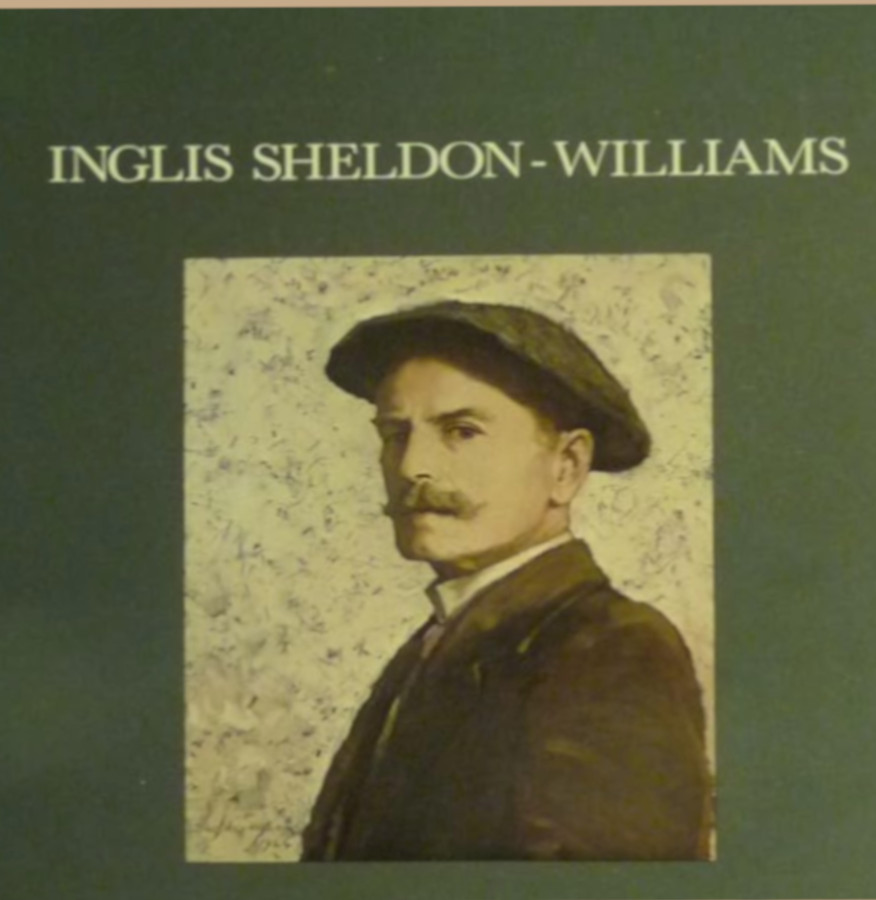Biography

Front cover of Patricia Ainslie's monograph on the artist.
Inglis Sheldon-Williams is thought of primarily as Canadian, because from the age of seventeen he was largely based in Saskatchewan, where he is reputed to have been "the first professional artist to have lived in that province" (Tennyson 500, n.711); and indeed it was in Canada that he really made his name. However, he was born into an artist's family in Hampshire and his ties to England remained strong throughout his life.
As a young man, he travelled both to England and France for his art training, entering the Slade in 1896. Rather surprisingly, he is said to have studied at some point under the eminent sculptor Sir Thomas Brock (see Wingfield 322 and Morgan 16), perhaps as a draughtsman — which is how he is described in the National Portrait Gallery's brief biography. Travelling continued to be an important feature of his life. He went to South Africa during the Boer War as a war artist for the journal, The Sphere, and travelled in India and Europe as well, before marrying another promising artist, Ina Maud Thomson (1876-1955), in England in 1904. The couple settled down in Gloucestershire for the next nine years, and had two daughters, Eve and Christina; Eve too would become an artist. All this while he was working as an illustrator and exhibiting his paintings and watercolours in various galleries, including the Royal Academy, and at the Paris Salon. He was also writing, and an article he both wrote and illustrated in the International Studio of August 1907 reveals something of his high ideals — of his belief that the "perfected work" alone was the artist's "richest desireable recompense" (112).
His own greatest success was yet to come. In 1913 he returned to Saskatchewan and became well known there by painting works of Canadian interest: "His work had developed from the 19th-century English tradition of Romanticism," writes Paul Fudge, "with the emphasis placed on the story or subject of a painting. He captured the feelings of vastness and loneliness of the prairies, and his best work was produced in Regina during the next five years." This included portraits that he was commissioned to make of such important dignitaries as the Premier of Saskatchewan, the Hon. Walter Scott. A mark of his recognition was that in 1916 he was given the task of organising the School of Art at what was then Regina College — now the University of Regina. He also taught some classes there for a while. His patron, Norman Mackenzie, was the local lawyer and art collector whose collection of works would form the basis for the Norman Mackenzie Art Gallery at the University, later to become a public gallery within the provincial government's T.C. Douglas building ("Mackenzie Art Gallery").
Then, in 1918, designated an official Canadian war artist, Sheldon-Williams left for Europe again. "He made an attempt to return to Canada in 1924, but was unable to find work," says Fudge, telling us that he had a nervous breakdown in the following year. He published two illustrated travel books in the later 20s: A Dawdle in France (1926), and A Dawdle in Lombardy and Venice (1928), the latter after moving to Italy, but the decade seems to have been a difficult one for him. Having spent the next several years in Italy, where he stayed until 1927, he finally moved back to England, and passed the last six years of his life there. He died in Tonbridge, Kent, in 1940.
Brian S. Osborne numbers Sheldon-Williams among those who "merit further attention as recorders of the vernacular and heroic" (177, n.19), and this seems to be a fair, perhaps even too modest, claim to make for him. — Jacqueline Banerjee

Tent Pegging at the Delhi Durbar of 1903,
from a print in private ownership.
Works
- The Delhi Durbar. Assault at arms. The 15th Bengal Lancers tent pegging
- Showery Weather
- The End of a Day's Work
Bibliography
Ainslie, Patricia. Inglis Sheldon-Williams. Calgary, Albert: Glenbow Museum, 1981.
Fudge, Paul. "Sheldon-Williams, Inglis (1870-1940)." Encyclopedia of Saskatchewan. Web. 18 September 2024.
"Inglis Sheldon-Williams (1870-1940, Draughtsman." National Portrait Gallery. Web. 18 September 2024.
Morgan, Richard. "The Flitwick Artists." History in Bedfordshire. Vol. 9, no. 7 (Spring 2022): 11-22. Available on the web at http://www.bedfordshire-lha.org.uk/wp-content/uploads/2022/03/HIB-9.7.pdf
Osborne, Brian S. "The Iconography of Nationhood in Canadian Art." In The Iconography of Landscape: Essays on the Symbolic Representation, Design and Use of Past Environments. Edited by Denis Cosgrove and Stephen Daniels. Cambridge: Cambridge University Press, 1988. 162-177.
Sheldon-Williams, Inglis. "Bits of Old China." International Studio Vol. 32 (August 1907): 111-15. Internet Archive. Web. 18 September 2024.
Tennyson, Brian Douglas. The Canadian Experience of the Great War: A Guide to Memoirs. Plymouth: Scarecrow Press, 2013.
Wingfield, Mary Ann. A Dictionary of Sporting Artists: 1650-1990. Woodbridge, Suffolk: Antique Collectors' Club, 1992.
Created 18 September 2024